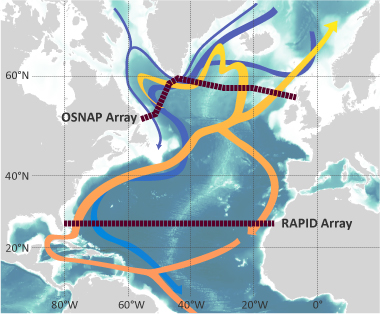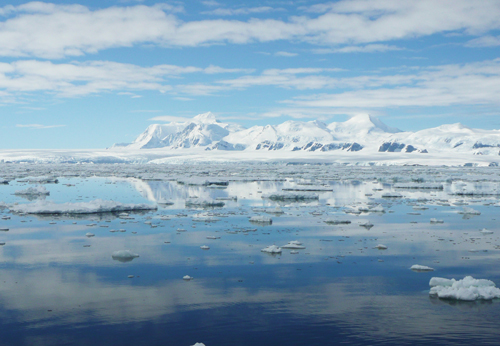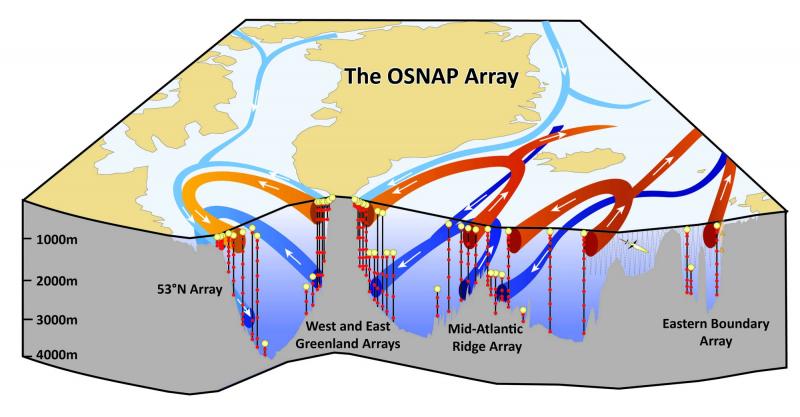Project information
What is the Subpolar Gyre and why is it important?
The North Atlantic subpolar region lies between roughly 45°N and 65°N, between the subtropics to the south and the Nordic Seas to the north. A ‘gyre’ is a large system of rotating currents driven by winds, and the North Atlantic Subpolar Gyre circulates anti-clockwise.

At the southern edge of the gyre the North Atlantic Current brings warm subtropical water into the eastern Subpolar region; most of that warm water circulates around the gyre, but some escapes and flows northwards between Greenland and Scotland and into the Nordic Seas. The gyre is deep, with the whole upper 1km of the North Atlantic circling in this way. The gyre is a key component of the climate system because it is a region where the ocean warms the atmosphere (keeping North Europe relatively mild) and because it draws atmospheric carbon dioxide into the deep ocean.
The warm water brought into the Subpolar Gyre releases heat into the colder atmosphere as it makes its way round the gyre. The properties of the waters change en route; they cool, become fresher and absorb carbon dioxide. This change is called ‘water mass conversion’ and the resulting water masses are dense and sink below the surface layers, flowing southwards away from the Subpolar Gyre. Because of this water mass conversion the Subpolar Gyre is one of the places where the Atlantic Meridional Overturning Circulation (AMOC) is not simply warm surface water flowing north and cold deep water flowing south; here, like the Nordic Seas, the AMOC here also takes the form of water moving down from the surface to below 1000m deep.
The Subpolar Gyre is also influenced by water from the Arctic; cool fresh Arctic water is a major ingredient in the western boundary currents of the gyre. The presence of light surface Arctic water can greatly influence the water mass conversion and therefore the downward movement of NAC water.
What do we mean by ‘fluxes’ and ‘storage’?

We use the word ‘fluxes’ to describe the movement of heat and freshwater between the atmosphere and the ocean. For example, in the Subpolar Gyre the ocean cools, losing heat to the atmosphere and this transfer of energy is called heat flux. In the Arctic, heavy precipitation and river run-off means there is a flux of freshwater from the atmosphere to the ocean. The Subpolar Gyre though does not continually get colder and colder, and the Arctic ocean does not continually get fresher and fresher, because the ocean and atmosphere work together to move heat and freshwater across latitudes to maintain a relatively steady climate pattern. The AMOC and the large ocean gyres are the key physical features that perform this redistribution of heat and freshwater.
The amount of heat and freshwater held within a part of the ocean is called ‘storage’, and understanding (and modelling) the relationships between heat and freshwater storage, fluxes and circulation is crucial to understanding and predicting local and global climate.
Why is more research needed?
Knowledge and understanding of the functioning of the Subpolar Gyre have increased, but ocean measurements have been patchy in time and space, so that the new understanding they generate is usually local to the measurements and not readily transferred to regional scale and beyond (such as the AMOC). We lack even a single coast-to-coast and surface-to-sea-bed measurement of circulation and fluxes in the Subpolar Gyre between North America and Europe.
The current generation of ocean circulation and climate models do not represent the Subpolar Gyre accurately, and existing measurement systems are inadequate for the task. The RAPID–MOCHA array at 26.5°N (http://www.rapid.ac.uk/rapidmoc) has opened our eyes to the surprisingly variable mid-latitude AMOC. So, to understand the contributions of the Subpolar Gyre and the AMOC to climate, observations of Subpolar Gyre circulation and fluxes are required, along with the modelling and analysis required to deliver new understanding of processes critical to the improvement of climate models.
What are we doing?
The UK-OSNAP team is developing a new observing system and innovative modelling techniques to characterise the circulation and fluxes of the North Atlantic Subpolar Gyre. We will provide a continuous record for four years (2014–18) of full-depth, trans-basin mass, heat, and freshwater fluxes in the Subpolar Gyre. UK-OSNAP will be part of an international collaboration to establish a transoceanic observing system in the subpolar North Atlantic (the OSNAP array). Our second aim is to quantify and understand the Subpolar Gyre’s response to local and remote forcing of mass, heat and freshwater fluxes, within the conceptual framework of the AMOC.
To achieve the aims, we have a suite of specific project objectives:
- to contribute to the OSNAP array with measurements in the Deep Western Boundary Current in the Irminger Basin, and the Eastern Boundary,
- to generate a seasonally-resolved time series of Subpolar Gyre circulation and isopycnal and diapyncal mixing rates and their contribution to net fluxes of heat and freshwater, from 2001, and for each of the Subpolar Gyre sub-basins. We will use a new inverse method applied to Argo data and supplemented by ECCO ocean state estimates,
- to identify the link between Subpolar Gyre heat storage and convergence in ocean heat transport. We will use dynamical assimilation and forward model experiments to develop diagnostics of ocean heat content change and heat transport convergence, and to explore the link to atmospheric forcing regimes,
- to quantify and understand the local and remote causes of the observed Subpolar Gyre variability using a combination of adjoint modelling at non-eddying resolution to determine sensitivities, and high resolution eddy-permitting forward modelling to test sensitivity robustness,
- to develop metrics appropriate to the Subpolar Gyre mass, heat and freshwater fluxes, by exploring improvements to the ‘flat’ and ‘tilted’ metrics via inclusion of horizontal circulation and Ekman fluxes, and testing in models, inverse solutions and the OSNAP array.
Project Management

We make 6-monthly progress reports to our funding agency, NERC, and you can read those here:
- Progress Report May 2021
- Progress Report October 2020
- Progress report May 2020
- Progress report November 2019
- Progress report May 2019
- Progress report October 2018
- Progress report May 2018
- Progress report September 2017
- Progress report February 2017
- Progress report July 2016
- Progress report January 2016
- Progress report July 2015
- Progress report January 2015
- Progress report July 2014
- Progress report January 2014
Other reports:





